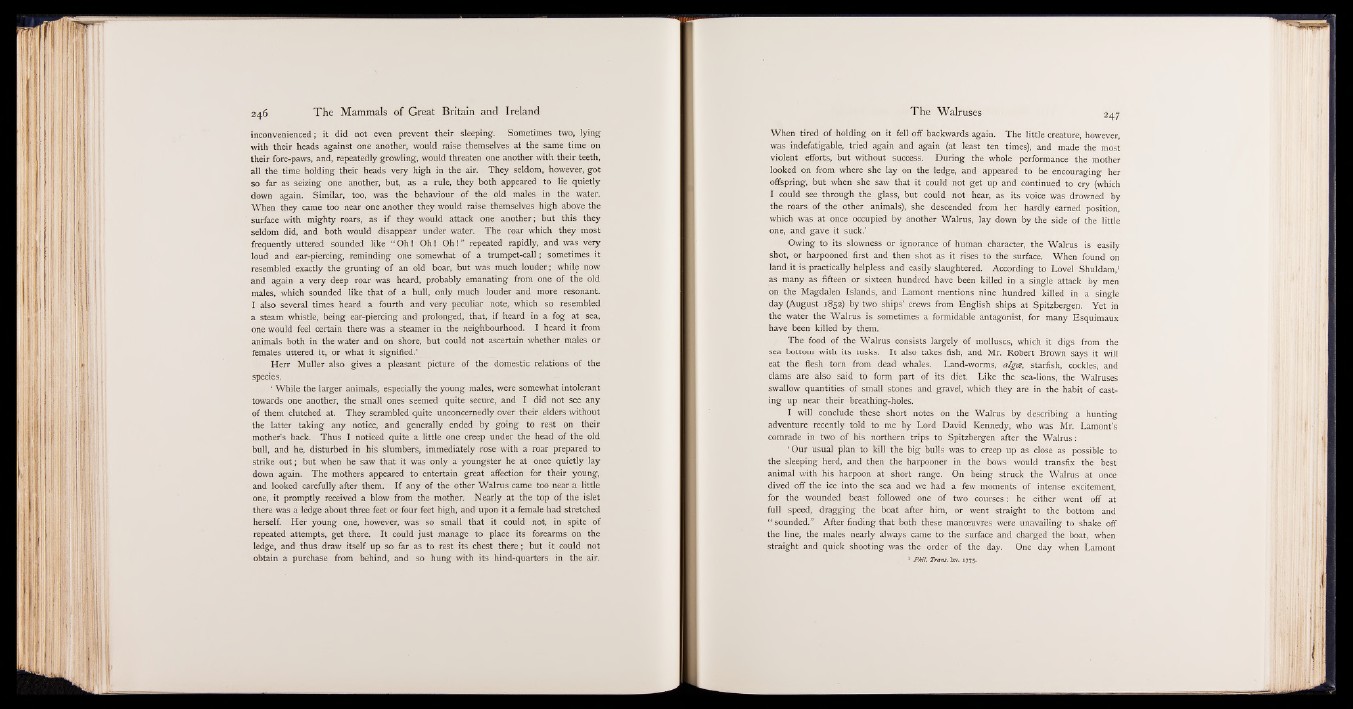
inconvenienced; it did not even prevent their sleeping. Sometimes two, lying
with their heads against one another, would raise themselves at the same time on
their fore-paws, and, repeatedly growling, would threaten one another with their teeth,
all the time holding their heads very high in the air. They seldom, however, got
so far as seizing one another, but, as a rule, they both appeared to lie quietly
down again. Similar, too, was the behaviour of the old males in the water.
When they came too near one another they would raise themselves high above the
surface with mighty roars, as if they would attack one another; but this they
seldom did, and both would disappear under water. The roar which they most
frequently uttered sounded like “ O h! Oh! Oh! ” repeated rapidly, and was very
loud and ear-piercing, reminding one somewhat of a trumpet-call; sometimes it
resembled exactly the grunting of an old boar, but was much louder; while now
and again a very deep roar was heard, probably emanating from one of the old
males, which sounded like that of a bull, only much louder and more resonant.
I also several times heard a fourth and very peculiar note, which so resembled
a steam whistle, being ear-piercing and prolonged, that, if heard in a fog at sea,
one would feel certain there was a steamer in the neighbourhood. I heard it from
animals both in the water and on shore, but could not ascertain whether males or
females uttered it, or what it signified.’
Herr Muller also gives a pleasant picture of the domestic relations of the
species.
‘ While the larger animals, especially the young males, were somewhat intolerant
towards one another, the small ones seemed quite secure, and I did not see any
of them clutched at. They scrambled quite unconcernedly over their elders without
the latter taking any notice, and generally ended by going to rest on their
mother’s back. Thus I noticed quite a little one creep under the head of the old
bull, and he, disturbed in his slumbers, immediately rose with a roar prepared to
strike out; but when he saw that it was only a youngster he at once quietly lay
down again. The mothers appeared to entertain great affection for their young,
and looked carefully after them. If any of the other Walrus came too near a little
one, it promptly received a blow from the mother. Nearly at the top of the islet
there was a ledge about three feet or four feet high, and upon it a female had stretched
herself. Her young one, however, was so small that it could not, in spite of
repeated attempts, get there. It could just manage to place its forearms on the
ledge, and thus draw itself up so far as to rest its chest there; but it could not
obtain a purchase from behind, and so hung with its hind-quarters in the air.
When tired of holding on it fell off backwards again. The little creature, however,
was indefatigable, tried again and again (at least ten times), and made the most
violent efforts, but without success. During the whole performance the mother
looked on from where she lay on the ledge, and appeared to be encouraging her
offspring, but when she saw that it could not get up and continued to cry (which
I could see through the glass, but could not hear, as its voice was drowned by
the roars of the other animals), she descended from her hardly earned position,
which was at once occupied by another Walrus, lay down by the side of the little
one, and gave it suck.’
Owing to its slowness or ignorance of human character, the Walrus is easily
shot, or harpooned first and then shot as it rises to the surface. When found on
land it is practically helpless and easily slaughtered. According to Lovel Shuldam,1
as many as fifteen or sixteen hundred have been killed in a single attack by men
on the Magdalen Islands, and Lamont mentions nine hundred killed in a single
day (August 1852) by two ships’ crews from English ships at Spitzbergen. Yet in
the water the Walrus is sometimes a formidable antagonist, for many Esquimaux
have been killed by them.
The food of the Walrus consists largely of molluscs, which it digs from the
sea bottom with its tusks. It also takes fish, and Mr. Robert Brown says it will
eat the flesh torn from dead whales. Land-worms, alges, starfish, cockles, and
clams are also said to form part of its diet. Like the sea-lions, the Walruses
swallow quantities of small stones and gravel, which they are in the habit of casting
up near their breathing-holes.
I will conclude these short notes on the Walrus by describing a hunting
adventure recently told to me by Lord David Kennedy, who was Mr. Lamont’s
comrade in two of his northern trips to Spitzbergen after the Walrus :
‘ Our usual plan to kill the big bulls was to creep up as close as possible to
the sleeping herd, and then the harpooner in the bows would transfix the best
animal with his harpoon at short range. On being struck the Walrus at once
dived off the ice into the sea and we had a few moments of intense excitement,
for the wounded beast followed one of two courses : he either went off at
full speed, dragging the boat after him, or went straight to the bottom and
“ sounded.” After finding that both these manoeuvres were unavailing to shake off
the line, the males nearly always came to the surface and charged the boat, when
straight and quick shooting was the order of the day. One day when Lamont
1 P h il. Trans, lxv. 1775.